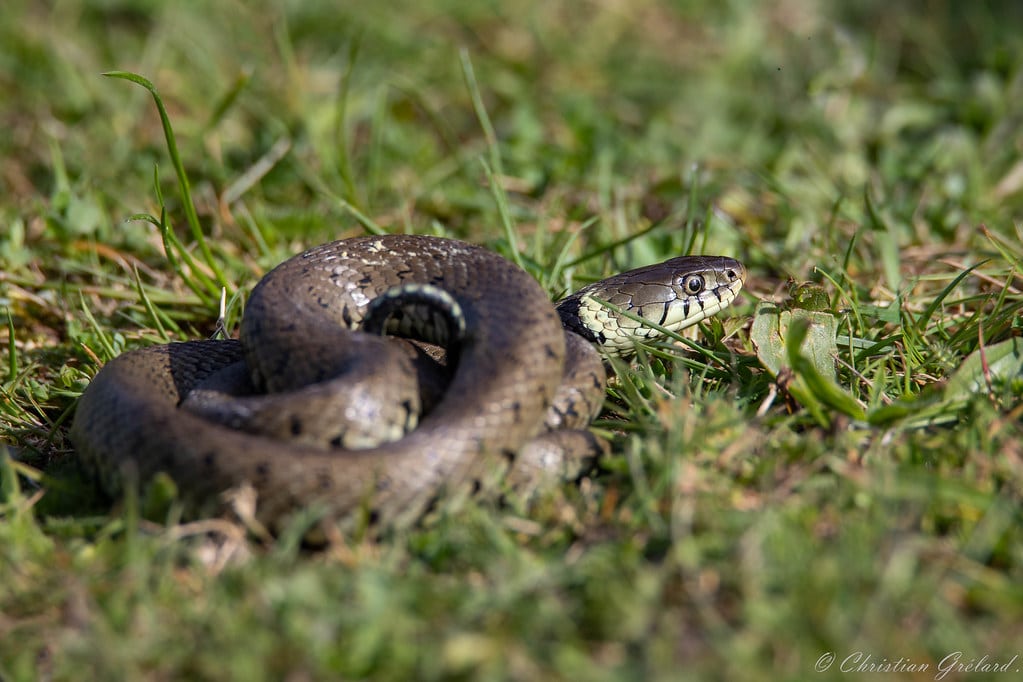Our article will be an in-depth reference for unique types of snakes in France.
It contains in-depth information about each species, such as intriguing facts, maps of their ranges, and defining traits.
There are many types of snakes in France, some of which are poisonous, while others rely on their ability to constrict their victim to subdue it.
Some snakes, including the Smooth Snake and the Adder, frequently live near people.
Our article will describe the characteristics of each type of snake in France, including their appearance, habitat, behavior, and diet.
It also addresses the conservation difficulties linked with particular snakes, such as the destruction of habitat and the killing of non-venomous species due to misconceptions about whether or not they are dangerous.
Let’s go!
1. Smooth Snake
One of the non-venomous types of snakes in France is the Smooth Snake (Coronella austriaca).
Its body is long and narrow, attaining lengths ranging from 50 to 70 centimeters on average.
The smooth snake derives its name from its flat, even, smooth scales, giving it an overall shiny appearance.
It can be gray or brown in color, and it often has darker markings on its back and flanks.
The body’s coloring might vary. One of the distinguishing features of this species is a dark splotch on the rear of the head, which can be seen more clearly in males.
2. Western Montpellier Snake

Malpolon monspessulanus, often known as the Western Montpellier Snake, is also on our list of snake types in France.
Individuals can reach lengths between one and two meters, earning it a reputation as an outstanding species.
The body of a Montpellier snake is normally yellow or light brown and coated in microscopic scales.
This snake has a thin body. Its head is pointed and pointy and has a characteristic eye stripe behind each eye.
3. Asp Viper

The Asp Viper, also known as Vipera aspis, is one of the most poisonous snakes in France.
It is notorious for its highly poisonous bite, and a bite from these types of snakes in France can harm humans.
The body of the asp viper is strong and may generally grow to a length of 60 to 80 centimeters.
It is possible to find people who are gray or brown and individuals who are reddish or yellowish-brown.
In addition to having a triangle-shaped head, it has a characteristic zigzag pattern running over its back.
4. Viperine Snake

France is home to the Viperine Snake (Natrix maura), which is not poisonous.
People frequently confuse the two because of its name and resemblance to other vipers.
The viperine snake’s body is quite slender, and it may normally grow to a length of about 70 centimeters to one meter.
It may appear light brown or gray, with darker lines running down the back and sides of its body.
A yellow or light green stripe that runs from the animal’s eye to its neck is one of the defining features of this species.
5. Green Whip Snake

Green Whip Snake (Hierophis viridiflavus) can grow up to one meter and is distinguished by having a slim and elongated body.
The green whip snake’s brilliant green color makes mixing well with the surrounding plants possible.
The underside of its abdomen is typically yellow. It has a pointed head, huge eyes, and circular pupils.
6. Iberian Grass Snake

The Iberian Grass Snake (Natrix astreptophora) can be found in the southwestern region of France and on the Iberian Peninsula.
It has traits that set it apart from other species of grass snakes despite having a similar outward appearance.
The body of an Iberian grass snake is normally greenish-gray or brown, and it may have spots or shades of darker color running along its back.
It has a slender body that may grow to approximately 70 centimeters in length, and the underside of its belly is often yellow or cream in color.
7. Barred Grass Snake

Although the barred Grass Snake (Natrix helvetica) shares many physical characteristics with the more common grass snake, these types of snakes in France can be identified by their distinctive coloring and patterning.
The barred grass snake’s body is olive-brown, and it has a series of dark bars or stripes running along its back and flanks.
It has a spherical head characterized by its wide eyes and a belly normally yellow or cream.
8. Aesculapian Snake

France is home to a species of snake called the Aesculapian Snake, which belongs to the genus Zamenis longissimus and is also known as the Large Whip Snake.
There have been reports of individuals of these types of snakes in France, reaching lengths of over two meters, making them very large.
Its body is normally brown or gray, and dark scales run along its back. Its shape is narrow and elongated.
The head of the Aesculapian snake is distinctly shaped, noticeably broader than its neck, and the pupils of its eyes are spherical.
9. Adder Snake

The adder, or Vipera berus, is the only poisonous snake species indigenous to the United Kingdom, including some areas of France.
It can be recognized by its stocky body, triangular head, and peculiar zigzag pattern running along its back.
The color of these types of snakes in France sometimes goes from shades of brown and gray to reddish-brown.
Compared to men, females typically have a brighter color, particularly on the rear of the head, which is more noticeable in males.
France is home to a wide variety of snake species, many of which are secretive and difficult to find.







